
The wildlife of Eswatini is composed of its flora and fauna. The country has 107 species of mammals and 507 species of birds.

The wildlife of Eswatini is composed of its flora and fauna. The country has 107 species of mammals and 507 species of birds.
Grassland, savanna, mixed bush, and scrub cover most of Swaziland. There is some forest in the highlands. Flora include aloes, orchids, and begonias.

The Cenozoic is Earth's current geological era, representing the last 66 million years of Earth's history. It is characterized by the dominance of mammals, birds and flowering plants, a cooling and drying climate, and the current configuration of continents. It is the latest of three geological eras since complex life evolved, preceded by the Mesozoic and Paleozoic. It started with the Cretaceous–Paleogene extinction event, when many species, including the non-avian dinosaurs, became extinct in an event attributed by most experts to the impact of a large asteroid or other celestial body, the Chicxulub impactor.

Giovanni Antonio Scopoli was an Austrian physician and naturalist. His biographer Otto Guglia named him the "first anational European" and the "Linnaeus of the Austrian Empire".

Wallacea is a biogeographical designation for a group of mainly Indonesian islands separated by deep-water straits from the Asian and Australian continental shelves. Wallacea includes Sulawesi, the largest island in the group, as well as Lombok, Sumbawa, Flores, Sumba, Timor, Halmahera, Buru, Seram, and many smaller islands. The islands of Wallacea lie between the Sunda Shelf to the west, and the Sahul Shelf including Australia and New Guinea to the south and east. The total land area of Wallacea is 347,000 km2 (134,000 sq mi).

Peter Hamilton Raven is an American botanist and environmentalist, notable as the longtime director, now President Emeritus, of the Missouri Botanical Garden.
Natural history of Scotland concerns the flora, fauna and mycota of Scotland.
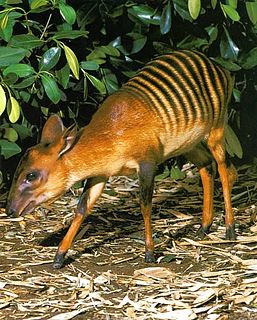
The zebra duiker is a small antelope found primarily in Liberia, as well as the Ivory Coast, Sierra Leone, and occasionally Guinea. They are sometimes referred to as the banded duiker or striped-back duiker. It is believed to be one of the earliest duiker species to have evolved.

The island of Great Britain, along with the rest of the archipelago known as the British Isles, has a largely temperate climate. It contains a relatively small fraction of the world's wildlife. The biota was severely diminished in the last Ice Age, and shortly thereafter was separated from the continent by the English Channel's formation. Since then, humans have hunted the most dangerous forms to extinction, though domesticated forms such as the dog and the pig remain. The wild boar has subsequently been reintroduced as a meat animal.
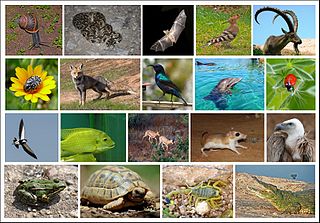
The wildlife of Israel includes the flora and fauna of Israel, which is extremely diverse due to the country's location between the temperate and the tropical zones, bordering the Mediterranean Sea in the west and the desert in the east. Species such as the Syrian brown bear and the Arabian ostrich have become extinct in Israel because of their loss of habitat. As of May 2007, 190 nature reserves have been established in Israel.
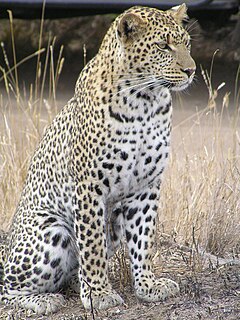
The wildlife of Equatorial Guinea is composed of its flora and fauna.

The wildlife of Uganda is composed of its flora and fauna. Uganda has a wide variety of different habitats, including mountains, hills, tropical rainforest, woodland, freshwater lakes, swamps and savanna with scattered clumps of trees. The country has a biodiverse flora and fauna reflecting this range of habitats and is known for its primates, including gorillas and chimpanzees. There are ten national parks and thirteen wildlife reserves; some 345 species of mammal and 1020 species of bird have been recorded in the country.

The wildlife of Eritrea is composed of its flora and fauna. Eritrea has 96 species of mammals and a rich avifauna of 566 species of birds.

The wildlife of Lesotho is composed of its flora and fauna. Lesotho has 60 species of mammals and 339 species of birds.

The wildlife of Tunisia is composed of its flora and fauna. It has 84 species of mammals and 375 species of birds. Tunisia is well documented for its addax and Dama Gazelle population.

The wildlife of Somalia includes the flora and fauna of Somalia, which is extremely diverse due to the country's location between the temperate and the tropical zones. Somalia has a long coastline, bordered by the Indian Ocean in the east and Red Sea in the north. The Northwestern and Central parts of the country are arid, or very dry. The Southern and Northeastern regions are semi-arid, receiving slightly more rainfall than the Central and Northwest regions. The Coastal region is more humid due to its proximity to the ocean. Somalia is home to over 727 species of birds and boasts over 177 species of mammals.
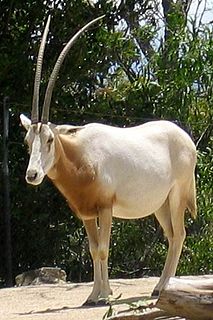
The wildlife of Western Sahara is composed of its flora and fauna. It has 40 species of mammals and 207 species of birds.
The wildlife of Sudan is composed of its flora and fauna. It has 287 species of mammals and 207 species of birds.
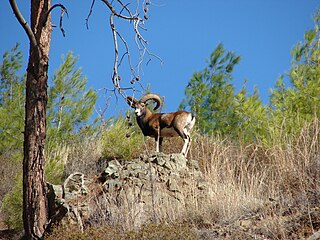
The wildlife of Cyprus includes its flora and fauna and their natural habitats. Cyprus has a rich flora and a diverse fauna albeit with relatively few mammals. Like most modern countries, the natural habitats in Cyprus have been steadily disappearing, currently retaining only 20% of its original habitat due to rapid urbanization, usage of forests for commercial purposes, tourism and various other reasons. One of the unique features of Cyprus' habitats is the wild and sharp differences in elevations and habitats in different parts of the island as well as different climate conditions, all of which supply a diverse habitat for a unique array of fauna and flora.

The Togian babirusa, also known as the Malenge babirusa, is the largest species of babirusa. It is endemic to the Togian Islands of Indonesia, but was considered a subspecies of Babyrousa babyrussa until 2002. Compared to the better-known north Sulawesi babirusa, the Togian babirusa is larger, has a well-developed tail-tuft, and the upper canines of the male are relatively "short, slender, rotated forwards, and always converge". The Togian babirusa is omnivorous, feeding mainly on roots and fallen fruit but also worms and invertebrates. Unlike other pig species, the Togian babirusa does not root at the ground with its snout when foraging, but instead can be seen pawing at the ground to uproot plants.

The Northwestern Himalayan alpine shrub and meadows is a montane grasslands and shrublands ecoregion of the elevations of the northwestern Himalaya of China, India, and Pakistan.

The wildlife of Somaliland includes the flora and fauna of Somaliland, which is extremely diverse due to the country's location between the temperate and the tropical zones. Somaliland is bordered by the Red Sea. The Coastal region is more humid due to its proximity to the ocean. Somaliland is home to over 727 bird species and boasts over 177 species of mammals.